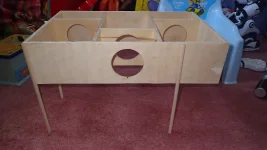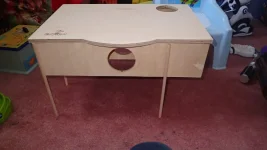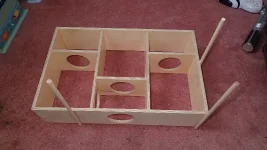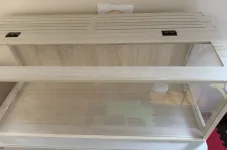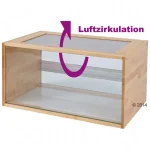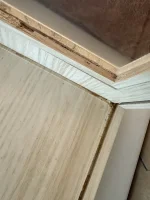That's a fantastic wheel - lucky hammy

As it's height extends between 33.5cm and 47cm I'm wondering if you could just have the wheel on the base of the cage, extended to the full height on the stand. And not need a platform for it to stand on. If it's 47cm high at it's tallest height then you'd need the wheel at the back of the cage really - at one end maybe. You'd have less substrate in that area but can slope it up deeper further away from it.
And yes you can make your own platforms and legs/stilts. Pine wood is probably easiest as long as it's kiln dried. It's hard to find formaldehyde-free plywood. I've just bought beech dowels before but hardwood is harder to cut/saw to the right length (for me anyway!). You can get pine ones as well. For houses I used to use the thin ones and just glue them to the house (I'll add an example below) so they were permanently fixed. That was before you could buy stilts commercially!
For platforms you might need 2cm diameter ones or more and screw through from the top of the platform down into the dowel (drilling a hole first is the easiest way). Working out the right height for everything is the tricky part ha ha. Even when you work it out, the bedding can flatten down at times or the hamster rearrange it! But rule of thumb is to have a platform about 2" above the substrate. Any higher and ramps and access are tricky.
There are lots of things you can make. I made some low steps out of circles of cork bark (cut from a cork branch) and stuck those together (tip - plastikote is good for things like that too - no glue needed - it just sets them together).
Making a multiroom house would be great. It really is just a box with compartments and holes cut for doorways.
This is one I had (with the glued on thin dowel legs).
This one I had was one of the best layouts. The hamster almost always nested in the front left largest compartment - because it was the darkest area - light doesn't go round corners. At the other side, the hole in the roof let light in. But the do love going down a top entrance hole and popping out of it again.
This was a Rodipet house (I think they were one of the first to ever make them in Germany - also Getzoo). They don't make this one any more. There are lots of similar ones but it annoys me that they don't think about how the hamster will use it! Eg the top entrance hole in the wrong place so there is no dark compartment.
This one was about 41cm wide by 26cm deep and about 9cm tall. It fitted most of the width of the cage so I had it at one end and it doubled up as a platform.
The only reason it has offset legs is because it was to fit in a barred cage which had a sloping base, so I couldn't have the rear legs too near the back.
Lots of diy ideas in this section as well

And a whole thread on what you can make with cardboard. Pringles tubes make good tunnels (wiped out).

www.thehamsterforum.com
This is a thread to show how many things you can make for your hamster or enclosure, out of cardboard :-) Cardboard is your friend.

www.thehamsterforum.com
I'll have a think about the raw ends and maybe others will have some ideas as well - it's still summer holidays so people are busy. But basically if you can spray disinfectant I think it will get into most crevices and if it was me I'd just paint the edges with plastikote. Some people might put metal strips on them!
While the round entrance holes were very nice on that house, I've found that when hamsters get older, they used to struggle climbing over the bottom part, so we then just cut the bottom parts out so they were u shaped entrances instead of round ones.
These were made from birch plywood which was apparently formaldehyde-free. Plywood would be easier for making a house - pine would be ok - a bit heavier but ok if supported with legs. But it would need to be that bit bigger to allow enough space in the compartments. Pine better for platforms maybe.
The safe woods article was written and researched by
@Daisy . If she's around, she might have some ideas on the edges of your cage as well.
